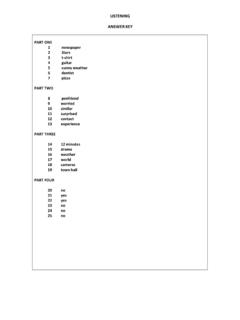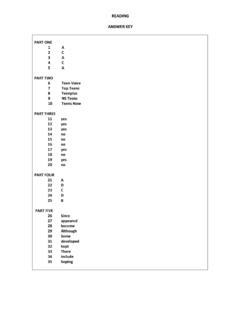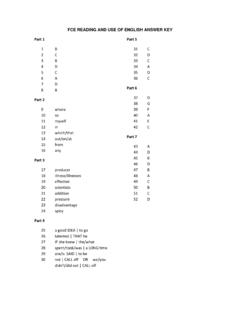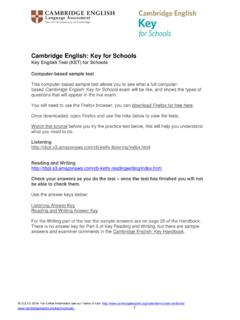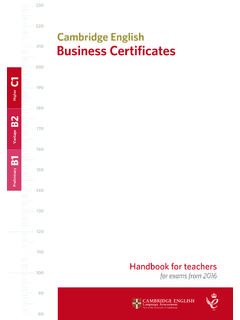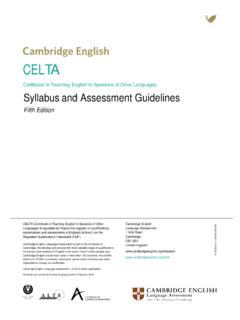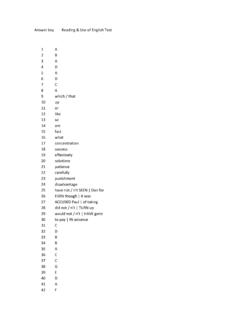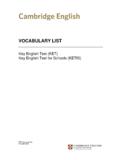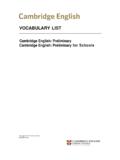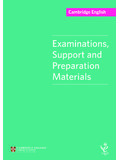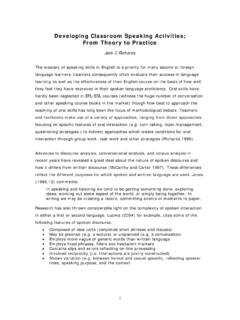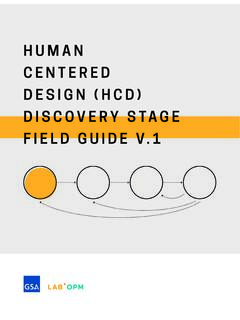Transcription of C1 Advanced Speaking Part 2 self-access lesson
1 1 Prepare for exam success: C1 Advanced self-access learning Speaking part 2: long turn lesson summary The topic of this lesson is happiness. In the lesson you will: review the format of part 2 of the Speaking paper. learn how to design your own Speaking part 2 practice tasks. use an online dictionary to increase the range and accuracy of your vocabulary. use online resources to improve your pronunciation. review useful language for speculating and comparing. build on your ability to speak confidently for more than a minute. use a checklist of assessment criteria to reflect on your performance. Get to know the exam: Speaking part 2 You will be paired with another candidate for the Speaking paper, which has 4 parts in total. In Speaking part 2 you will: compare and speculate about two photographs.
2 Talk on your own for a minute without interruption. listen to your partner s talk and answer a question about their photographs. It helps to know how you are going to be assessed, and what you are assessed on. The task is assessed using the following criteria1: Grammatical Resource: Can you demonstrate that you know and can use a range of simple and more complex grammatical structures accurately? Lexical Resource: Can you show that you can use a range of simple and complex vocabulary to talk about familiar and unfamiliar topics. Are you able to use this vocabulary correctly? Discourse Management: Is your answer an appropriate length for the task (1 minute)? Are you able to speak without much hesitation or repetition? Is what you say relevant to the task?
3 Is your answer structured? Does it include use of discourse markers because, however, in addition, as a result, therefore, on the other hand, furthermore, to sum up? Pronunciation: How easy is it to understand what you are saying? Can you demonstrate that you can use intonation to enhance and convey meaning? Is your word and sentence stress correct? Are individual sounds correctly produced? Interactive Communication: Did you listen when the other candidate spoke about their pictures? Are you able to react to what they said? 1 UCLES 2011 adapted from 2 Prepare 1: Create a practice task In the first part of this lesson , you are going to work through a series of steps, which involves conducting online picture research and then creating your own practice tasks.
4 Step 1: Find pictures to practice with The topic for this lesson is happiness. Go to an image website such as Google images or Type the word happiness in the search field to view images of different things that make people happy. Select up to five pictures before deciding on the three images from your picture search that you can easily compare and contrast. Step 2: Brainstorm ideas / generate vocabulary Use the images and make a list of your own ideas and useful vocabulary linked to what you think: makes an introverted person happy makes an extroverted person happy makes you happy Need help? Here is an example to get you started. Introverts Extroverts You curling up with a good book having a big party with friends .. Look at your ideas and decide whether you think you are an introvert or an extrovert.
5 Step 3: Write three questions Write down two questions for Student A to answer about the pictures and one question for Student B to answer. You are not going to describe the pictures. The questions you write should encourage the speaker to compare, contrast and speculate about the pictures on the theme of happiness. Compare your questions with the sample questions in the need help box below. 3 Need help? Here is an example task. Student A: Compare two of the pictures and say why people might feel happy when they do these kinds of activities. Do you think these activities would make everybody happy? 2 Student B: Which activity do you think is the most enjoyable? Prepare 2: Vocabulary building online dictionary research In the Speaking task, you need to show you can use a range of vocabulary at different levels.
6 Some of this vocabulary should be at C1 level or above. When you look up words in the Cambridge Dictionary you can check for the level. 3 Research task 1. Return to the list of ideas and vocabulary you made in Prepare 1, Step 2. a. Research up to five of the words from your list, in the online dictionary. b. Check their level. c. How many are C1 level or above? Research task 2. Look at these words and phrases another student wrote down. Check the level of words a) and b) in the dictionary. Now think about phrases c) to f). Which of the phrases are collocations? Which are idioms? a) alone b) solitary c) solitary pursuits d) have a party e) curl up with a good book f) keep to oneself 2 Photos by Lenin Estrada, Samantha Gades and Priscilla Du Preez on Unsplash 4 Check your answers in the Answer Key at the end of the lesson .
7 Research task 3. Choose two or three of the lower level words you wrote down. Go to the More Examples and Thesaurus information in the online dictionary to find any of the following: a higher level synonym a related idiom a collocation. Need help? Here is an example to guide you. An introvert might prefer to be alone - look up alone and you can see the word is A2 level. In the examples section, notice how the word is used as an adverb as well as an adjective. This kind of information can help you use the word more accurately in different sentences and expressions Now scroll down and look in the Thesaurus section, there are many words and phrases with similar meanings. You can check the part of speech and the definition by clicking on the links.
8 Bonus task: Follow the link to Cambridge Dictionary + Plus and record any new vocabulary you have learned. You can test yourself at any time using the quiz feature. 5 Prepare 3: Review useful language to compare and speculate Below are some useful phrases to help you compare and speculate about the pictures you chose. Match the useful phrases to the four headings shown in the table below. What distinguishes the two pictures is .. They might be .. They re quite alike in that .. I m going to compare the picture on the left with the one in the centre. I wouldn t be surprised if .. A common feature of both photos is .. The biggest difference between them is .. In certain respects the pictures are quite similar because .. They may well I ve chosen the photograph that shows.
9 And the one with .. While / Whereas the people in one photo seem to be .., in the other one people are .. 4 Saying which pictures you re talking about Describing similarities Describing differences Speculating I ve chosen the photograph that shows .. and the one with .. 4 Task adapted from Compact Advanced Student s Book Cambridge University Press and UCLES 2014 6 Top tip Vocabulary building Record useful words and phrases in your notebook or create vocabulary flashcards like the examples below. Make each phrase more memorable by writing an example sentence to show how it can be used. Example: Try to use new words and phrases each time you speak English Prepare 4: Review and rehearse pronunciation Look back at your notebook and check any new words or phrases you have learned in the lesson so far.
10 It s important you know how to say these with the correct sounds and stress. There are many useful free online resources to help you with pronunciation. These are great options for you if you want to practise at home. Try the following tasks with two of the online tools. Which one works best for you and why? If you like it, why not bookmark it so you can try it again. 1. is a useful free online resource for practising pronunciation of common phrases, as well as words. It also helps you to familiarise yourself with native speaker pronunciation (this will help with Listening too). 1. Type in the word you want to pronounce and click Search. 2. Use the arrow keys at the bottom of the screen to scroll through different clips of native speakers pronouncing the word.
